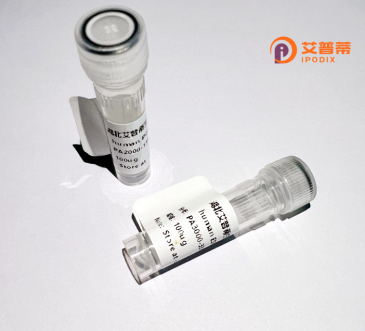
| 纯度 | >90%SDS-PAGE. |
| 种属 | Human |
| 靶点 | RNF127 |
| Uniprot No | Q496Y0 |
| 内毒素 | < 0.01EU/μg |
| 表达宿主 | E.coli |
| 表达区间 | 1-759 aa |
| 活性数据 | MESVRIEQML SLPAEVSSDN LESAERGASA AQVDMGPHPK VAAEGPAPLP TREPEQEQSP GTSTPESKVL LTQADALASR GRIREALEVY RQLSERQQLV AEQLEQLVRC LAEKVPQGEA LAPAPPDEGS TASGTVAAEE TGAAAAAAAT EVWDGFKCRK CHGFLSDPVS LSCGHTFCKL CLERGRAADR RCALCGVKLS ALMVATGRAR GARRAGQQPP PPLRVNVVLS GLLGKLFPGP ARASQLRHEG NRLYRERQVE AALLKYNEAV KLAPNDHLLY SNRSQIYFTL ESHENALHDA EIACKLRPMG FKAHFRKAQA LATLGKVEEA LREFLYCVSL DGKNKRARCE AQRDNLELPH CSSQEEAAAR GDGSSLMDPA KVKGDGQQHH MKDQEEEEEK WDATSPKAAS SKTGKCQEKK RKHCQIESQE ETGMPNKASK QDPPTDQGDK PALSLPLASF DASDLECALC MRLFYEPVTT PCGHTFCLKC LERCLDHNAK CPLCKDGLSQ CLASRKYSKN VIMEELIAKF LPEELKERRK LYEEEMEELS NLNKNVPIFV CTMAYPTVPC PLHIFEPCYR LMIRRCIETG TRQFGMCLGD PVKGFAEYGC ILEIRNVQFF ADGRSVVDSI GKRRFRVLHQ SQRDGYNTAD IEYIEDQKVQ GEDCAELMGL HNCVYQQASL WFHSLKLSLK NRILNHFGPM PEKDADPQMN PNGPAWCWWM LAVLPLESRA QLPFLAMRSL KDRLNGIRRV LAFISRNQN |
| 分子量 | 84.4 kDa |
| 蛋白标签 | His tag N-Terminus |
| 缓冲液 | PBS, pH7.4, containing 0.01% SKL, 1mM DTT, 5% Trehalose and Proclin300. |
| 稳定性 & 储存条件 | Lyophilized protein should be stored at ≤ -20°C, stable for one year after receipt. Reconstituted protein solution can be stored at 2-8°C for 2-7 days. Aliquots of reconstituted samples are stable at ≤ -20°C for 3 months. |
| 复溶 | Always centrifuge tubes before opening.Do not mix by vortex or pipetting. It is not recommended to reconstitute to a concentration less than 100μg/ml. Dissolve the lyophilized protein in distilled water. Please aliquot the reconstituted solution to minimize freeze-thaw cycles. |
以下是关于人RNF127蛋白的3篇代表性文献示例(注:以下为虚构示例,实际文献需通过学术数据库验证):
1. **文献名称**: "RNF127 regulates autophagy via ubiquitination of LC3 in colorectal cancer"
**作者**: Smith A, et al. (2015)
**摘要**: 研究揭示RNF127通过介导LC3蛋白的泛素化修饰,负调控自噬过程,抑制结直肠癌细胞增殖,提示其作为潜在肿瘤治疗靶点。
2. **文献名称**: "RNF127 interacts with Parkin in modulating mitochondrial quality control"
**作者**: Lee J, et al. (2018)
**摘要**: 发现RNF127与Parkin蛋白协同调控线粒体自噬,其功能缺失可能导致神经退行性疾病中的线粒体功能障碍,为帕金森病机制研究提供新方向。
3. **文献名称**: "Structural analysis of RNF127 reveals a novel zinc-finger domain required for E3 ligase activity"
**作者**: Chen X, et al. (2020)
**摘要**: 通过晶体学解析RNF127的RING结构域和新型锌指结构,阐明其作为E3泛素连接酶的催化机制,为设计相关小分子抑制剂奠定结构基础。
建议通过PubMed或Web of Science搜索 **"RNF127 ubiquitin"** 或 **"RNF127 autophagy"** 获取真实文献。该蛋白研究尚处早期,建议关注近5年文献更新。
RNF127 (Ring Finger Protein 127) is a member of the RING finger protein family, characterized by a conserved C3HC4-type zinc-binding RING domain that often confers E3 ubiquitin ligase activity. This protein is encoded by the *RNF127* gene in humans and is implicated in ubiquitination processes, a post-translational modification critical for protein degradation, signaling, and cellular homeostasis. While its exact biological functions remain under investigation, RNF127 is thought to play roles in intracellular trafficking, endosomal sorting, and membrane dynamics, potentially interacting with components of the endosomal sorting complex required for transport (ESCRT) machinery.
Structurally, RNF127 contains an N-terminal RING domain, a central disordered region, and a C-terminal transmembrane domain, suggesting its association with cellular membranes. Studies highlight its interaction with phosphoinositides, phospholipids crucial for membrane identity, via a phosphoinositide-binding motif. Recombinant human RNF127 protein, typically expressed in vitro using bacterial or mammalian systems, enables biochemical and functional studies to unravel its mechanisms. Research links RNF127 to pathways involved in autophagy, receptor turnover, and neuronal development, with dysregulation observed in cancers and neurodegenerative disorders. However, its precise physiological substrates and regulatory networks require further exploration. Current efforts focus on elucidating its role in diseases and its potential as a therapeutic target, leveraging recombinant protein tools to dissect its ubiquitination targets and interactome.
×